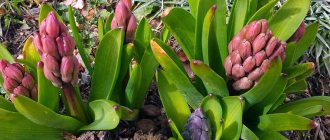Features and characteristics of zephyranthes
The main representative of the Amaryllis family can be safely called a perennial, represented by a bulbous plant called zephyranthes. This is a decorative flowering plant, as it gives beautiful inflorescences. Among the huge variety of marshmallows, we can safely say that a large number of varieties can be grown in a flower garden on the site, although the subtropical countries of Central, South and North America, as well as Argentina, are considered to be the birthplace of the plant. Remember, if your region is warm and harsh winters are more an exception than a classic, then growing zephyranthes in open ground is acceptable. As an alternative, you can grow zephyranthes at home, but with the arrival of summer, simply place flowerpots with a beautiful flowering plant on the streets, and with the onset of cold weather, bring them back into the middle.
The main name of zephyranthes is very complex for many, so a more “folk” version was rightfully adopted, which calls the flower “rain lily.” This name is quite expected, since the plant really has similarities with a lily in its flowering, although the size of the buds is significantly smaller in size, compared with the real “mistress”.
The root of the plant is a bulb, which has different diameters depending on the variety, but the average size is 3 cm. The shape of the bulb resembles an egg, which is covered with a rather dark shell. The bulb is the basis of the future plant, so it is at this moment that it must be strictly controlled. When planting zephyranthes in open ground, you only need to completely immerse the bulb in the soil - nothing else.
The foliage emerges directly from the bulb. They are long - 30 cm, narrow and linear, and the rosette itself is extremely narrow. Also, in addition to the foliage, a peduncle 20-25 cm long appears from the bulbs, at the end of which there is a single flower, which has a funnel shape, which is very similar to a lily. The diameter of the flower is not standard, since it all depends on the variety; the parameters range from 4 to 10 cm. The color range of the inflorescences is varied - pink, white, yellow, red. Multicolor inflorescences are popular, where several shades are combined, combining two or even more shades and tones in one petal, turning each flower into a real masterpiece.
The flowering period is a bright culmination that delights everyone, but this process can occur at different times of the year. Spring, summer or even winter is the prerogative of a single variety of zephyranthes. For open ground, the best varieties are those that are fragrant in the spring and summer.
Description of the flower
The bulbs of the plant are round or oblong, the length can be about 35 mm. There is a small basal neck that promotes the formation of a leaf rosette. The foliage is narrow, belt-shaped, rich green in color. The leaves can reach 20-35 cm in length.
It blooms in early April and until the end of summer. The flowers are similar in shape to crocuses, the colors are white, yellow and pink. The diameter of the flower is from 40 to 80 mm. The bud lives 1-3 days.
How to grow zephyranthes in your garden or flower garden?
As you know, zephyranthes can reproduce in two ways - by seeds and by dividing the bulb. The seed method for open ground is a practically impossible task, unless you patiently carry out all the preparatory work on the formation of a young plant at home, and only then transfer the plant to the site. Another thing is dividing the onion. The children that form around the main bulb need to be separated and planted in a new place, which will make it possible to successfully begin the growing season.
Zephyranthes is capable of forming more than 10 children in one plant, which are completely suitable for use as planting material. The process of separating the bulbs should be carried out no earlier than the plant is completely dormant, because this is the only way you will not be able to harm the main zephyranthes. Remember, storing bulbs in winter should be done exclusively at home. Further, there are two options - store the bulbs until spring in order to later plant them in open ground, or root them immediately and transplant a fully formed plant into the soil in the spring.
Diseases and pests
During growth, zephyranthes may suffer from a variety of diseases and pests:
| Disease/pest | Signs | Treatment |
| Shchitovka | Brown plaques form on the foliage and stem. Leaves become dull and deformed. | The affected areas are wiped with Actellik solution. |
| Amaryllis mealybug | Between the scales of the bulb there are small white insects. There is a slowdown in plant growth, the foliage dries out and dies. | The soil is treated with an insecticide. Severely affected bulbs are removed. |
| Spider mite | The flowers fall, the plant gradually withers and becomes covered with a thin white web. | Zephyranthes are treated with a solution of water and soap. In difficult situations, spray with Actellik. |
| Whitefly | The foliage turns yellow and falls off, there is no flowering. | The plant is sprayed with products that contain permethrin. In severe cases, Actelik is used. Reduce the number of waterings. |
| Fusarium The bulb severely affected by the disease is destroyed. | The roots rot, the foliage withers and turns yellow. | Plants located in the neighborhood are kept in the Maxim solution for 30 minutes and then planted in new soil. |
Features of growing marshmallow varieties in open ground
Anyone who wants to have such a beautiful plant on their property as zephyranthes must understand that these plants are heat-loving, so they need a warm climate. In temperate climates, the process of growing marshmallows should be limited to growing in open ground only in the summer, and at home in cooler seasons. If the region is warm enough and belongs to the south, then planting zephyranthes in a flower garden is quite possible with full development and a successful ending. Let's look at common varieties that are ideal for growing on site.
If your climate is still moderate, then growing only those varieties that have only early flowering to their credit. Pink and large-flowered specimens of varieties are considered bright representatives. If zephyranthes will be used as an annual to enjoy during the summer flowering period, then feel free to choose the variety that you like, since everyone can bloom successfully.
Popular types for home
There are about 40 varieties of marshmallows, of which no more than 10 can be grown at home:
| View | Description | Flowering period |
| Atamascian | Herbaceous plant with a small bulb and neck. In total there are 6-8 tubular leaves, the length of which is up to 20 cm. The buds are white with a yellow center, diameter from 25 to 40 mm. | Beginning of March - May. |
| Snow-white | The flower reaches a height of 30 cm. The diameter of the bulb is up to 30 mm, the neck is elongated. The color of the buds is white, the perianths are funnel-shaped. | From July to October. |
| Golden | Height up to 30 cm, the bulb has a round shape, the foliage is narrow. Flowers are funnel-shaped, yellow in color. | March-April – mid-summer. |
| Pink | The bulb is elongated with a diameter of about 3 cm. The flowers are light pink with a yellow core. | Mid-spring – July. |
| Multicolored | It stands out for its original colors, combining shades of red. |
How to choose successful planting material?
Many flower growers are confident that purchasing from a specialized store is a guarantee of success. Alas, this does not always coincide with reality. Ordinary garden stores are just distribution points, so purchasing old or overdried bulbs may be no exception, which will ultimately ensure very long germination and a slow growing season. As a result, flowering appears in the 3rd or even 4th year of the growing season. There is a way out of this situation - the purchase of planting material should be carried out exclusively in nurseries or specialized centers for the sale of high-quality planting material. The ideal option would be to purchase bulbs that have already been planted in containers by professionals, observing optimal conditions and recommendations for each plant. This is the only way to have at least some guarantees and assert the quality of planting material.
Reproduction methods
The basic principle of breeding marshmallows is, of course, bulbous. However, there is also a seed method. It is used much less frequently and takes more time and effort.
To “multiply” an upstart in this way, you need to manually pollinate. To do this, pollen from the stamens is transferred to the pistils using a soft, sterile brush.
Zephyranthes grown from a bulb (photo)
Then the bud is tightly covered with gauze for several days. If the work is done correctly, then after the flower withers, seeds will form. The ripening time is approximately two months.
It is advisable to use the resulting material immediately, since germination capacity is lost very quickly and during long-term storage the grains may not produce results at all.
The land used for planting is the same as for main cultivation, but with the addition of one part of peat.
The mixture is compacted in a container, leveled and moistened. Seeds are laid out on the surface at intervals of 2-3 cm. Then the pot is covered, transferred to a shaded place and kept at a temperature above 20°. Sprouts will begin to appear in a few weeks. After this, the shelter is gradually removed, and the container “migrates” to the windowsill.
Specimens raised from seeds will be covered with bells after three years.
Expert opinion
Yulia Yurievna
I have a large garden and vegetable garden, several greenhouses. I love modern methods of cultivating plants and mulching the soil, and I share my experience.
Ask a Question
An ideal place on the site for growing marshmallows
After successfully purchasing planting material, an equally important step will be not only the correct planting in the flower garden, but also the choice of the optimal location. Since zephyranthes is a heat-loving exotic, only a sunny and warm place should be allocated for this flower. At the same time, fertile soils are a clear plus for the growing season, so when choosing a site, make sure that the soil is of high quality.
Zephyranthes can smell fragrant not only in a flower bed or flower garden; you can decorate rock gardens with this gorgeous plant, since the combination of inflorescences and stone can increase the value of not only the plant itself, but also the structure. Any hill can also be considered a good place for marshmallows, which will help avoid the accumulation of moisture, which is unacceptable for successful growth.
Is it possible to keep marshmallows at home?
There is an opinion that the upstart flower cannot be kept at home, let's figure out why. The only thing that comes to mind is that this is due to its toxicity.
All parts of marshmallow are poisonous! Place the flower pot so that children and pets cannot reach it.
A much less weighty reason is the Feng Shui instructions that say: you should keep flowers with rounded petals at home. Whereas zephyranthes, and this can be seen in any photo, is distinguished by pointed petals, which means that it carries Yang energy - a rather heavy and difficult to manage male, active energy. If the “Yang” plant is placed incorrectly, it can cause harm energetically, but with the right approach it will only bring benefits.
Thus, flowers with sharp petals, including zephyranthes, are not recommended to be placed in the bedroom (as, indeed, any indoor plants according to Feng Shui). The best place for them is a living room or office. Here the active energy of the upstart will be very useful.
The main rules for planting zephyranthes in open ground
- Boarding time. The first thing you should know is that planting occurs in the spring, but after the soil has warmed up as much as possible. That is why it is difficult to talk about an exact date; it all depends on your region. The main rule is to take your time so that the bulbs do not freeze.
- The soil should be properly prepared. For this purpose, it is best to completely dig up the area, loosen it, and only then level it.
- Humidification of the area. Next, the soil must be thoroughly flooded so that the area remains moist for a long time.
- Inspection of planting material . Before planting, you should inspect the bulbs again. Any suspicion of poor quality must be completely rejected for planting. Only high-quality bulbs should be planted - this is not a rule, but a law.
- Number of landings. The norm is to immerse one bulb in the soil. Alternatively, you can expand this rule and plant several bulbs at the same time.
- Planting depth. This moment depends on the filler material, or rather on the presence of a neck. If it is short, then the bulb is completely lowered into the soil, but long ones are left slightly above the surface level.
- Watering the planting. The final touch in planting will be watering.
Types of marshmallows with names
Zephyranthes atamascus
In nature, the species is found in the southern part of the United States. The ovoid bulb reaches a little more than 20 mm in diameter, the surface of the neck is covered with bark. One bush grows up to 6 pieces of narrow, linear-shaped leaf blades. In white flowers, lanceolate petals reach about 40 mm in length. The species blooms in the first half of spring. It is recommended to grow in cool rooms.
Zephyranthes white
The bulb of the species is round and reaches about 30 mm in diameter, the length of the neck is up to 50 mm. The leaf blades appear on the bush at the same time as the flowers and are more than 0.3 m long. The flowers are similar in appearance to crocus flowers and, as a rule, are painted white, their length is about 60 mm. Blooms from mid-summer to the second half of autumn.
Golden
The ovoid-rounded bulb reaches about 30 mm in diameter. The linear leaf blades are approximately 30 centimeters long. The funnel-shaped flowers, widened towards the middle, are colored yellow. The species blooms in winter.
Zephyranthes grandiflora
In this species, the neck of the bulb is short, and the diameter itself reaches about 30 mm. The grooved narrow leaf plates of linear shape are about 30 centimeters long and up to 1 centimeter wide. The pinkish-red flowers consist of lanceolate petals, which are about 50 mm long. The species blooms from the second half of spring to mid-summer.
Zephyranthes versicolor
The oblong bulb has a diameter of about 30 mm. The leaf plates that grow after the flowers reach a length of about 30 centimeters. The outer surface of the white flowers has a reddish-green tint. Blooms in January.
How to care for zephyranthes in open ground?
The process of caring for zephyranthes in the open ground is a difficult but feasible task for everyone, because the main thing is to clearly know all the points that will favorably affect the development of the plant on the site.
- How to water zephyranthes correctly? Remember, the appearance of flower stalks and, accordingly, flowering depends on watering, so strict adherence to watering rules is the basis for successful flowering. Zephyranthes loves moisture, but not its abundance, so the quantity should be controlled. Make it a rule - often, but not too much. Excess moisture means the bulb can begin to rot, which will ultimately destroy the entire plant. Watering should be done only at the root and not with cold water. The ideal option would be settled, warm water. With the onset of dormancy, as evidenced by the complete loss of leaf mass, it is imperative to completely stop watering.
- Basic rules for feeding marshmallows. In order for the plant to enjoy bright and fragrant flowering for a long time, fertilizer should be applied at the beginning of the appearance of buds. Mineral complexes are suitable for these purposes, which will fully provide the necessary nutrition that the rain lily so needs.
- Loosening rules. Adequate oxygen supply is an important aspect of the growing season. That is why loosening is an element of care that should not be disturbed. Make it a rule to fluff up the soil after each watering. You should not neglect the procedure, but at the same time, there is no point in overdoing it either. Control the bulb, you should not injure it.
Zephyranthes (upstart)
Zephyranthes is a perennial bulbous flowering plant, popularly called “upstart”.
Interesting! This exotic flower is unique in that it shoots out a peduncle very quickly and is in a hurry to bloom literally the next day. In nature, zephyranthes (upstart) develops in high humidity, so it prefers to grow in the tropics.
Marshmallow flower
The leaves of the plant are long and narrow, the plant looks compact. The flowers resemble stars and bloom on thin, graceful stalks. Based on the color of the petals, 4 types of crops are distinguished: white-flowered, red-flowered, yellow-flowered and two-colored. The upstart flowers do not delight with their appearance for long, a maximum of a week, and then fall off.
Medicinal properties of the plant
The exotic plant is rich in various organic substances. It is often used in medicine: tinctures are made from the leaves to treat colds, liver diseases, diabetes, tuberculosis, and joint diseases.
The process of digging up bulbs and storing them
It is not recommended for bulbs to overwinter in open ground, so it is best to dig them up for the winter. For these purposes, the “harvesting” procedure should be carried out before the first frost - in the fall. The excavation process occurs with the presence of the entire above-ground part. The bulbs should be dried along with the foliage. You can get rid of the foliage after complete drying. Next, the bulbs are cleaned and immersed in dry containers that are pre-filled with sawdust inside. There is no need to create special conditions; standard room temperature will do.
Growing exotic plants on your own property is not such a common occurrence, although if you follow all the rules, you should not rule out the possibility of growing zephyranthes in open ground.
Join our Facebook group
Problems during cultivation
Most often, novice gardeners are interested in the reason why a houseplant turns yellow or why it does not bloom when the growing technology is followed. Flowering can be hampered by too high a temperature and an increased level of soil moisture during the dormant stage. In addition, the reason why the above-ground parts of the plant turn yellow may be insufficient lighting or an excess of nutritional components.
It is also important to consider that waterlogging the soil causes the bulbs to rot. Proper care minimizes the risk of plant damage by diseases and pests, but spider mites, whiteflies, scale insects and scale insects pose a potential danger to ornamental crops, for which it is recommended to use Actellik.
Why don't zephyranthes bloom?
The lack of buds may be due to improper conditions. For example, a too hot, dry or, on the contrary, cold climate does not allow flower stalks to form.
At this time, the flower spends energy on growing rhizomes and daughter bulbs.
You may not expect flowering if the substrate has not been renewed for a long time and has become depleted . To maintain the level of nutrients in the soil, you should regularly replant and fertilize the perennial.
Pests affecting zephyranthes
Zephyranthes is a rather unpretentious flower. It does not require any special conditions or complex procedures, and is also little susceptible to attack by insects, partly due to its toxicity. However, some pests can still appear on the flower. Among them: scale insects, amaryllis scale insects, and the eternal spider mite. Folk remedies or purchased chemicals will help you defeat them.
You can prevent their occurrence by spilling the substrate for planting or replanting the bulbs with boiling water and potassium permanganate. Just don’t forget to dry the soil after this procedure, because excess moisture is much more dangerous for an upstart flower than pests. As well as excessive dry air.
All this can be easily corrected: in particular, when water stagnates, the bulbs need to be dug up, dried and replanted in dry soil. And spraying with settled water will help cope with dryness.
Zephyranthes fade quite quickly, but thanks to the gradual appearance and opening of the buds, the upstart flower can please its owner with a fairly long flowering period. It will decorate your home flower collection with a spring mood, give it a touch of tenderness and add grace.
Rest period
After flowering ends, the growth of upstart zephyranthes slows down, and the foliage of many species falls off. A period of rest begins, which lasts from 3 months to six months. Dry leaves are cut off, the pot is covered with a special covering material, and transferred to a cool, dark room with an air temperature of +8...+16C. During the dormant period of zephyranthes, you should monitor the soil moisture; the bulb should not dry out. As soon as new leaves appear, the flower pot is returned to normal conditions.
vote
Article rating
Reviews from flower growers
Between flowering periods, Zephyranthes Lindleya looks unremarkable: narrow long leaves and nothing else. As soon as it starts to bloom, you can’t take your eyes off the plant. It is easy to care for. The plant reproduces by bulbs.
Zephyranthes is simply called "upstart". This name was given to it because this flower blooms unusually. Today there is nothing, but in the morning you look, he threw away the arrow, and the next day he blossomed. I got this flower quite recently; my mother brought two types. At first I was not particularly happy about this flower, because it looked like a decorative onion. But when they both bloomed, it looked absolutely gorgeous. One blooms white, reminiscent of a daffodil, and the second blooms pink. Very beautiful flowers that do not require any special care. In order for it to bloom better, it needs to be replanted. It blooms mainly in summer and for a very short time, but it is worth it to plant such a plant.
The flower took root, it liked it on my windowsill, it liked my care, and after a couple of months it pleased me with its first flowering. I was surprised, because there was no sign of flowering, and then I suddenly noticed an arrow, and a couple of days later the first beautiful flower. Then another and another - how beautiful it is when several flowers bloom at once. Three years have passed since the moment a flower appeared in my house, and my flowers (yes, I now have three pots of this beauty) have survived three moves, and they are all alive, all delighting with their blooms. I like the fact that the flower is completely unpretentious, it even loves direct sunlight, and loves to bathe in the shower. I have white flowering zephyranthes and now I really want to buy one with pink flowering. I recommend this flower - it is very easy to care for, but so beautiful, both during the dormant period (the greenery is bright, like the feathers of an onion) and during flowering.
Zephyranthes has been pleasing with its flowers for many years. Especially in early spring)) There is a pot, there is nothing but thin leaves, and then you wake up the next day, and there is already an arrow in the pot (hence the name upstart). But I prefer the name RAIN LILY. Since in nature the upstart usually blooms during the period of tropical rains)) I have a large-flowered upstart, there is almost no care for it, it stands in the scorching sun, however, it likes to be well watered and sometimes sprayed)) I replant it once every 2 years, in a pot a lot of bulbs are formed (that’s why I awarded bulbs to all my acquaintances and friends), I leave the youngest bulb for myself, but the more bulbs in 1 pot, the more arrow-flowers there will be))
I water it only once a week and a half. And he feels great, he stands on my windowsill, our side is not sunny, so he does not experience any inconvenience. Its greens are interesting, like onion greens, my mother calls it that - onion. It reminds me of chives, only the greens of zephyranthes are brighter, denser and juicier. Mine hasn’t bloomed yet, but I hope that next summer it will please me with its flowers.
Zephyranthes, despite its tropical homeland, is an unpretentious plant and easily lends itself to “home education.” Simple rules of care will result in joy for gardeners - bright and long flowering of the plant. Considering that different varieties of marshmallows bloom at all times of the year, you can ensure continuous decoration of your home.
I never cease to be convinced that life is wonderful. Rate this article:
(6 votes, average: 3.2 out of 5)
Rain lily, upstart, zephyranthes are the names of the same flower, which has firmly taken root on our windowsills and in our front gardens.
Zephyranthes flower from the amaryllis family. Humid subtropics are its usual habitat. Zephyranthes are medium-sized bulbous perennials with fast-growing flower stalks and wide-open flowers.
Zephyranthes flower in the photo
About 40 species of this flower are known. The most popular of them are:
- Zephyranthes white, or snow-white. It features white flowers on a long stalk. This species blooms from September to October.
- Zephyranthes pink, or red-flowered. It blooms from April to May and has pink flowers.
- Zephyranthes Lindley. Pink flowers reaching a diameter of 7 cm. Blooms from July to August. The most capricious of all zephyranthes.











